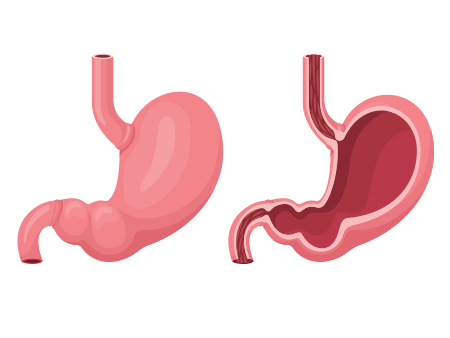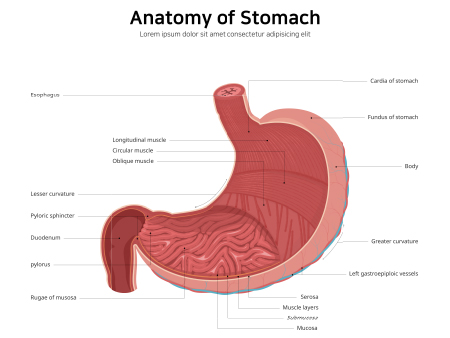What is a stomach? How does it work with the body?
The stomach is an organ that we happily keep full. The stomach is a muscular organ in the body that digests food. It is a part of the gastrointestinal tract where it receives food and produces digestive acids and enzymes to break down the food.
It is a J-shaped organ that produces a mix of enzymes and digestive juice to break down the food particles so they can pass into the small intestine. The stomach is present in the upper left abdomen next to the spleen.
The primary function of the stomach is to store and break down food particles or liquids that we consume before it enters the other organs of the GI tract to be further digested.
When the stomach is empty, the inside of the organ contains numerous small folds called rugae. These foldings allows the stomach to expand to accommodate large meals.
The stomach is the main organ for digestion that secrets a potent mix of gastric juice. These juices help digest food particles and are strong enough to digest most consumable products.
The stomach produces a mucus-like secretion to protect itself, prevent the adverse side effects of the solid digestive juices and eliminate auto digestion.
The cell lining in the stomach can produce the following ingredients in gastric juices.

Pepsin
Pepsin, a digestive enzyme made of a protein, is activated when food enters the stomach.
Hydrochloric acid
Hydrochloric acid also known as gastrointestinal hydrochloric acid is a strong acid that breaks down any foreign particles entering the stomach through the gastrointestinal tract.
After the stomach completes its part of work in the digestive process, the acidic mixture of the juices and food leaves the stomach and goes into the small intestine.
The chemicals in the stomach work with delicate balance. Various problems can arise due to several conditions that can disturb the natural chemical balance in the gut, causing
- Indigestion
- Nausea
- Vomiting
- Diarrhoea
- Burns
- Ulcers and
- Crohn's disease.
What is the function of the stomach?
The primary purpose of the stomach is to digest food and move it to the small intestine, where further digestion occurs.
The stomach is also responsible for
- Temporarily storing food
- Contract and relax to churn and break down food particles.
- Producing essential enzymes to digest food.
How does the stomach sync with the rest of the GI tract?
Every part of the gastrointestinal tract breaks down the food and liquid carried through the body. During the process, the body absorbs essential nutrients and water and discards the waste through the large intestine.
The food we eat moves through
The mouth
As we chew and swallow the food, the tongue pushes the food into the throat. Saliva produced will help the body break down food into smaller particles and helps with digestion.
Food pipe
The food pipe is also referred to as the oesophagus, where the food travels down through a hollow tube and reaches the bottom to enter the stomach.
Stomach
The stomach creates digestive juices to break down the food and hold it until the mixture is available for further digestion in the small intestine.
Small intestine
The food mixed with the digestive juices from the stomach comes into the small intestine, where the intestinal walls absorb nutrients and water essential for the body and moves the waste into the large intestine.
Large intestine
The large intestine is responsible for turning waste products into stool and pushing them out of the body through the rectum.
Rectum
The rectum is present below the large intestine and stores stool till we have a bowel moment. The waste from the body is excreted through the rectum.
How big is the stomach?
The size of the stomach differs from person to person. Visually, people can differentiate the size of a stomach based on how much a person has eaten.
Anatomy of the stomach
The stomach is segregated into five sections, namely.
The cardia
The cardia is the upper part of the stomach that contains the cardiac sphincter, which prevents food from travelling back to the oesophagus.
The fundus
The fundus is a round section near the cardia, below the diaphragm.
The corpus
The corpus is also referred to as the body of the stomach. It is also the largest section that contracts and expands to mix food.
Antrum
The antrum is nestled below the body of the stomach and holds the food until the stomach is ready to push it into the small intestine for further digestion.

Structure of the stomach
The stomach is made up of mucosa, submucosa, muscularisis, externa, and serosa.
Keeping the stomach healthy
The stomach contains several muscles and plays a vital role in digesting food.
A healthy stomach should digest food smoothly and be free of various stomach problems like indigestion, GERD, gastritis, gastroparesis, stomach cancer or peptic ulcers.
Gastrointestinal diseases can affect the stomach, cause severe symptoms under various circumstances and have a long-lasting effect on the body.
It is crucial to make lifestyle changes to keep the stomach and the digestive system healthy.
- Restricting the consumption of alcohol
- Consuming adequate water every day
- Eating enough fibre regularly
- Performing moderate exercises regularly
- Restricting the intake of processed food
- Adopting healthy stress management and coping strategies
- Quitting smoking and tobacco.
These are some of the ways in which a person can keep their stomach healthy. A regular visit to the doctor can also help in diagnosing various diseases and prevent further health decline.
It is important to visit a doctor if a person experience symptom like fever, chest pain, nausea, vomiting, blood in stool, severe abdominal pain, dehydration or diarrhoea.
If a person has chronic stomach symptoms, they must speak with a gastroenterologist.
A gastroenterologist is a doctor who specialises in treating the digestive system. They can help diagnose the cause of the symptoms and provide treatment accordingly.
To sum up
The stomach is a muscular organ that is a part of the gastrointestinal tract helping digestion. The J-shaped organ contracts, relaxes and produces acids that will break down food particles for digestion.
The size of the stomach can depend on how much a person eats.
Healthy lifestyle choices and managing stress effectively can keep the stomach and digestive system healthy.
FAQs
What are five facts about the stomach?
2. The stomach produces solid digestive juices that are highly acidic.
3. The stomach can protect itself from the acid it produces.
4. The stomach is the widest part of the digestive system.
5.The stomach stores food temporarily and pushes it into the small intestine for digestion.
How big is the empty stomach?
What are the three things that the stomach does?
2. Contract and relaxation to mix and break down food particles.
3. Produces enzymes and digestive juices to digest the food partially and push it to the small intestine for further digestion.
What are the seven functions of the stomach?
2. Breakdown of food particles
3. Disruption of chemical compounds in food material with the help of acid or enzymes
4. Partial digestion of food
5. Produce hydrochloric acid that kills bacteria
6. Secretes intrinsic factor
7. Push the food particles into the small intestine for further digestion.